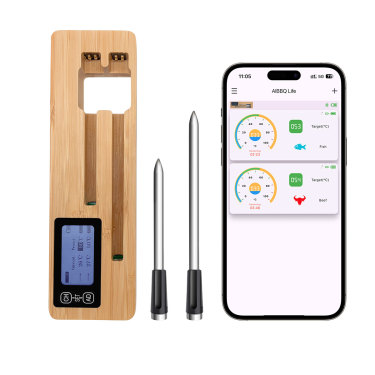
。
# Digital Meat Thermometer Guide
## Introduction to Digital Meat Thermometers
A digital meat thermometer is an essential tool for any home cook or professional chef. Unlike traditional analog thermometers, digital versions provide quick and accurate temperature readings, ensuring your meat is cooked to perfection every time. Whether you’re grilling, roasting, or smoking, a reliable digital meat thermometer can make all the difference in achieving the desired doneness and food safety.
## Why Use a Digital Meat Thermometer?
Using a digital meat thermometer offers several advantages:
– **Accuracy**: Digital thermometers provide precise temperature readings, often within a degree or two.
– **Speed**: Most digital models deliver readings in seconds, reducing guesswork and overcooking.
– **Versatility**: They can be used for various types of meat, including poultry, beef, pork, and fish.
– **Safety**: Ensuring meat reaches the correct internal temperature helps prevent foodborne illnesses.
## Types of Digital Meat Thermometers
There are several types of digital meat thermometers available, each suited for different cooking methods:
### Instant-Read Thermometers
These thermometers provide quick temperature readings and are ideal for checking the doneness of meat during cooking. Simply insert the probe into the thickest part of the meat, and the temperature will display within seconds.
### Leave-In Thermometers
Leave-in thermometers are designed to remain in the meat throughout the cooking process. They often come with a probe attached to a cord, allowing you to monitor the temperature without opening the oven or grill.
### Wireless Thermometers
Wireless digital meat thermometers allow you to monitor temperatures remotely via a smartphone app or a separate receiver. This is especially useful for smoking or slow-cooking meats over long periods.
## How to Use a Digital Meat Thermometer
Using a digital meat thermometer correctly is crucial for accurate results. Follow these steps:
1. **Insert the Probe**: Place the probe into the thickest part of the meat, avoiding bones or fat.
2. **Wait for the Reading**: For instant-read thermometers, wait a few seconds until the temperature stabilizes. Leave-in thermometers will continuously display the temperature.
3. **Check Multiple Spots**: For larger cuts of meat, check the temperature in several areas to ensure even cooking.
4. **Clean the Thermometer**: Always clean the probe after use to prevent cross-contamination.
## Recommended Internal Temperatures for Meat
Here are the USDA-recommended internal temperatures for various types of meat:
– **Poultry (chicken, turkey)**: 165°F (74°C)
– **Ground Meat (beef, pork, lamb)**: 160°F (71°C)
– **Pork (chops, roasts)**: 145°F (63°C) with a 3-minute rest
– **Beef (steaks, roasts)**: 145°F (63°C) for medium-rare, 160°F (71°C) for medium
– **Fish**: 145°F (63°C) or until flesh is opaque and flakes easily
## Choosing the Best Digital Meat Thermometer
Keyword: digital meat thermometer
When selecting a digital meat thermometer, consider the following factors:
– **Accuracy**: Look for models with a high degree of precision.
– **Speed**: Faster readings can be more convenient, especially for grilling.
– **Durability**: Choose a thermometer with a sturdy probe and waterproof design if needed.
– **Ease of Use**: Features like backlit displays and magnetic mounts can enhance usability.
– **Price**: Digital meat thermometers range from budget-friendly to high-end models with advanced features.
## Maintenance and Care
To ensure your digital meat thermometer lasts for years, follow these maintenance tips:
– **Clean the Probe**: Wash the probe with warm, soapy water after each use. Avoid submerging the entire unit unless it’s waterproof.
– **Calibrate Regularly**: Some models allow for
Comments are closed